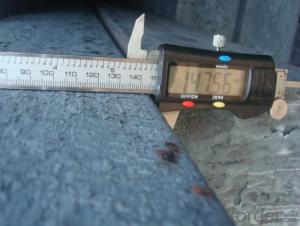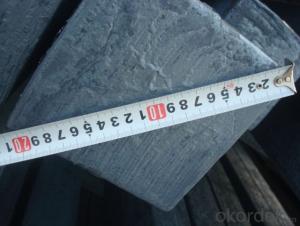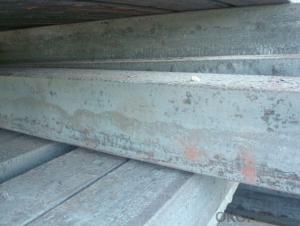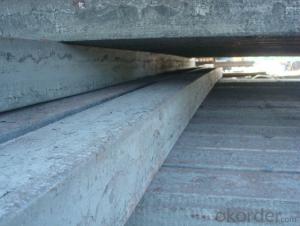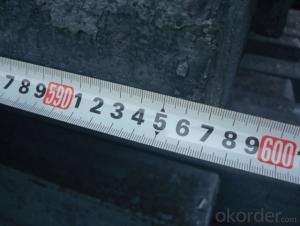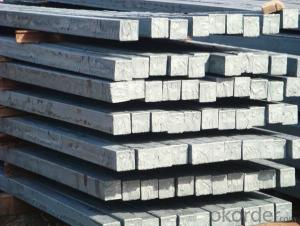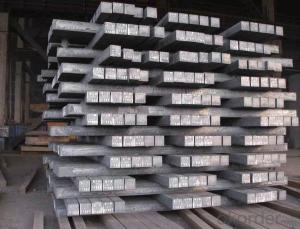Continue Casting Steel Bloom by Blast Furnace Manufactured by Big Steel Mill
- Loading Port:
- Tianjin
- Payment Terms:
- TT OR LC
- Min Order Qty:
- 1000 m.t.
- Supply Capability:
- 100000 m.t./month
OKorder Service Pledge
OKorder Financial Service
You Might Also Like
Continue Casting Steel Bloom by Blast Furnace Manufactured by Big Steel Mill
1.Structure of Continue Casting Steel Bloom by Blast Furnace Manufactured by Big Steel Mill
Continue Casting Steel Bloom by Blast Furnace Manufactured by Big Steel Mill is the raw material of all kinds of steel mill. Billet section of square, round, flat, rectangular and abnormity, etc Several, mainly related to shape of rolled products. Simple rolled section steel, choose cross section of square billet or rectangular billet. rolling The sector products such as flat steel, Angle steel, select the rectangular billet or slab. Had better profiled billet when production beams, channels, and in rolling process Lines and improve the yield. The raw material of round billet is the production of seamless tube.
2.Main Features of Continue Casting Steel Bloom by Blast Furnace Manufactured by Big Steel Mill.
Steel Bloom Manufactured by Blast Furnace section size should meet the requirements of rolling deformation and finished product quality, but also roll strength and biting condition of restrictions. General steel Billet section height H. And the roll diameter D The ratio of the ( namely H/D) Should be less than or equal to zero 0.5 . Length of steel billet by finishing temperature, Rolling time and the length of the product Or times ruler. When heated too long accident prone to bump the furnace wall of steel, too short, furnace bottom utilization rate is not high, influence the heating furnace production. For the production Choose a variety of steel and steel billet, should consider the affinities of billet, as far as possible in order to improve the productivity of the roughing mill, simplify the stock management of workshop.
3. Continue Casting Steel Bloom by Blast Furnace Manufactured by Big Steel Mill Images

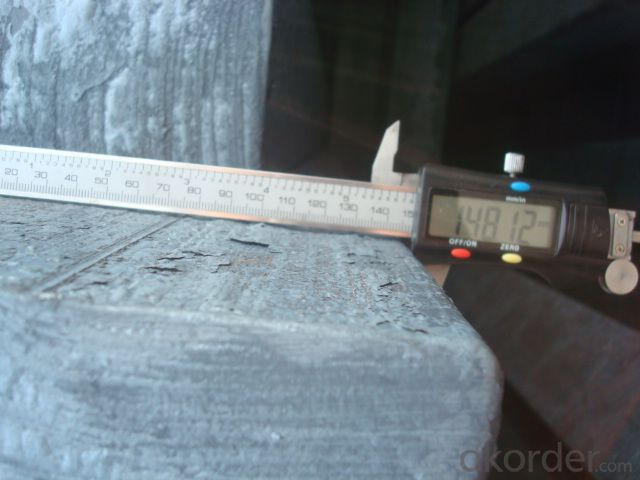
4. Continue Casting Steel Bloom by Blast Furnace Manufactured by Big Steel Mill Specification
Continue Casting Steel Bloom by Blast Furnace Manufactured by Big Steel Mill rolled steel, after processing can be used for mechanical parts, forging parts, processing all kinds of steel, steel Q345B channel steel, wire rod is the role of the billet. Steel billet is used in the production of semi-finished products, generally cannot be used directly for the society. Steel billets and steel are strictly divided into standard, cannot decide to whether the business enterprise of the final product, and according to unified standards to perform the whole society. Typically, billet and the steel is relatively easy to distinguish, but for some steel billet, and have the same specification and same steel purposes (such as rolling tube billet), whether can be used for other industries, whether through steel processing process, whether through a finished product rolling mill processing to distinguish
Material standard The editor Range of thickness: 150-240 - mm + / - 5 mm width range: 880-1530 - mm + / - 20 mm Length: 3700-10000 - mm + / - 500 - mm Cross-sectional size: 64 * 64; 82 * 82; 98 * 98; 124 * 124; 120 * 150; 152 * 164; 152 * 170 mm Length: 9000 mm Section of tolerance: billet: 1.0 + / - 2.0-1.0 + / - 1.0 mm slab: width: + / - 2.0 mm thickness: + / - 3.0 mm The length tolerance: + / - 200 mm Section diagonal tolerance: 3.5-8.0 MM Billet section size protrusions requirements: < 1242 mm, do not allow; > = 1242 mm, < = 2 mm 1242 mm, < = 3 mm Beheading (shear) extension deformation: < 1242 mm billet: no control; The slab: < = 15 mm Surface tilt: no more than billet section 0.1 Bending: every 1 m length is not more than 10 mm The distortion: length < = 5 m, < = 11. ; The length of the < = 7.5 M, < = 5. Material % 3 sp/PS chemical composition: C Mn Si S P
5.FAQ of Continue Casting Steel Bloom by Blast Furnace Manufactured by Big Steel Mill
We have organized several common questions for our clients,may help you sincerely:
①How about your company?
A world class manufacturer & supplier of castings forging in carbon steel and alloy steel,is one of the large-scale professional investment casting production bases in China,consisting of both casting foundry forging and machining factory. Annually more than 8000 tons Precision casting and forging parts are exported to markets in Europe,America and Japan. OEM casting and forging service available according to customer’s requirements.
②How to guarantee the quality of the products?
We have established the international advanced quality management system,every link from raw material to final product we have strict quality test;We resolutely put an end to unqualified products flowing into the market. At the same time, we will provide necessary follow-up service assurance.
③How is the standard of the steel billet products?
Continuous casting billet of carbon-steel chemical composition to perform "carbon structural steel"GB700-88.standard;Appearance quality inspection Implementing the continuous casting billet and the rectangular billet,YB2011-83Standard.
- Q: What are the different types of surface treatment methods used for steel billets?
- Some of the different types of surface treatment methods used for steel billets include pickling, shot blasting, and galvanizing. Pickling involves immersing the billets in an acid solution to remove scale and impurities. Shot blasting uses high-speed particles to clean and roughen the surface of the billets. Galvanizing involves coating the billets with a layer of zinc to protect against corrosion. Other methods, such as painting or powder coating, may also be used for specific applications.
- Q: How are steel billets used in the manufacturing of fasteners and fittings?
- Fasteners and fittings rely on steel billets as a vital raw material in their production. These components are essential for securely holding multiple parts together or connecting different sections of a structure or system. To create fasteners and fittings, steel billets undergo a series of steps. Initially, the billets are heated to a high temperature, making them malleable. Known as hot rolling, this heating process allows the billets to be shaped according to the desired form. Subsequently, the billets are passed through rollers that gradually decrease their thickness and increase their length. This transforms them into long, slender rods called wire rods. Next, the wire rods undergo cold drawing or rolling to refine their shape and dimensions further. This process enhances the rods' surface finish and strength. As a result, precise diameter wires are formed, which are then utilized in the production of fasteners such as screws, bolts, and nuts. The wires are cut to specific lengths and threaded to create the grooves and patterns essential for fastening. The threads enable easy screwing into other components, ensuring a secure and reliable connection. The size and shape of the threads are crucial as they determine the compatibility of the fasteners with various applications. In the case of fittings, additional processes are applied to the wire rods, including machining, bending, or welding. Machining involves using cutting tools to shape the wire rods into specific sizes and forms. Bending allows the wire rods to be molded into different angles or curves to fit the desired configuration of the fittings. Welding is employed to join multiple wire rods or other components, enabling the creation of complex fittings. After the manufacturing process, both fasteners and fittings undergo rigorous quality control tests to ensure they meet the required standards for strength, durability, and dimensional accuracy. These tests assess factors such as threading precision, hardness, and resistance to corrosion. In conclusion, steel billets play a crucial role in the production of fasteners and fittings. Through processes like hot rolling, cold drawing or rolling, threading, and various shaping techniques, steel billets are transformed into wires and further processed to create a wide range of fasteners and fittings. These components are vital in industries such as construction, machinery, and automotive.
- Q: How do steel billets contribute to the strength of a structure?
- Steel billets contribute to the strength of a structure by providing a high-strength, durable material that can withstand heavy loads and stress. Due to their composition and manufacturing process, steel billets offer superior strength and structural integrity, making them ideal for use in construction projects. They can be shaped and formed into various structural components, such as beams, columns, and reinforcement bars, which enhance the overall stability and load-bearing capacity of a structure. Additionally, the uniformity and consistency of steel billets ensure that the strength of the structure remains consistent throughout, further enhancing its overall strength and reliability.
- Q: How are steel billets cut into smaller pieces?
- Steel billets are typically cut into smaller pieces using a process called sawing or shearing. This involves using specialized machinery equipped with blades or shear tools to slice the billets into desired lengths or sizes.
- Q: Can steel billets be cold rolled?
- No, steel billets cannot be cold rolled. Cold rolling is a process that involves passing metal through rollers at room temperature to achieve a desired thickness and surface finish. Steel billets, on the other hand, are semi-finished metal products that are hot rolled into specific shapes.
- Q: What are the different types of steel billet rolling mill equipment?
- There are several different types of steel billet rolling mill equipment used in the manufacturing process. Some of the most common types include: 1. Reheating Furnaces: These are used to heat the steel billets to the required temperature before rolling. They use fuel or electricity to generate heat and ensure that the billets are at the optimal temperature for the rolling process. 2. Roughing Stands: These stands are responsible for reducing the size of the billets and preparing them for the subsequent rolling passes. They have multiple rolls that gradually decrease the thickness of the billets as they pass through. 3. Intermediate Stands: Once the billets have been roughed, they pass through the intermediate stands. These stands further reduce the thickness and shape the billets into the desired profile. 4. Finishing Stands: The billets then enter the finishing stands, which have a set of rolls that give the final shape and size to the steel. These stands are responsible for achieving the precise dimensions and surface finish required for the end product. 5. Cooling Beds: After the rolling process, the steel billets need to be cooled down gradually to prevent any distortion or cracking. Cooling beds provide a controlled environment for the billets to cool down before further processing. 6. Shearing Machines: These machines are used to cut the rolled steel billets into desired lengths. They can be hydraulic or mechanical, and they ensure precise and accurate cutting according to the specifications. 7. Straightening Machines: Sometimes, the rolled billets may have slight deformations or unevenness. Straightening machines are used to correct these imperfections and ensure that the steel is straight and ready for further processing. 8. Inspection Equipment: Various inspection equipment, such as ultrasonic testers, are used to check the quality and integrity of the rolled steel billets. These equipment ensure that the final product meets the required standards and specifications. Overall, these different types of steel billet rolling mill equipment work together to transform raw steel billets into finished products with the desired shape, size, and quality. The selection and arrangement of these equipment depend on the specific requirements of the manufacturing process and the end product.
- Q: What is the role of steel billets in the construction of sports facilities?
- Steel billets play a crucial role in the construction of sports facilities. These billets, which are essentially semi-finished steel products, are used as the primary raw material for manufacturing various structural components and equipment necessary for sports complexes. One of the key applications of steel billets in sports facility construction is in the production of steel beams and columns. These structural elements provide the necessary support and stability to the buildings, ensuring safety for athletes and spectators. Steel billets are melted and shaped into these beams and columns, which are then used to create the framework of the sports facility. Additionally, steel billets are also utilized in the fabrication of sports equipment such as goalposts, fencing, and handrails. These components require high strength and durability to withstand the physical demands of the sport and the wear and tear from extensive use. By using steel billets, these equipment can be manufactured to meet the required strength standards while also ensuring longevity and safety. Moreover, steel billets are used in the construction of seating areas and grandstands within sports facilities. The high load-bearing capacity and structural integrity of steel make it an ideal material for supporting large crowds. By using steel billets, these seating areas can be constructed to withstand heavy loads and provide a safe and comfortable environment for spectators. Furthermore, steel billets are also instrumental in the construction of roofing and façade systems. Steel panels made from these billets offer excellent resistance to weathering, corrosion, and fire, making them suitable for outdoor sports facilities. These panels can be fabricated to provide the necessary insulation, protection, and aesthetic appeal, enhancing the overall functionality and appearance of the sports complex. In conclusion, steel billets have a vital role in the construction of sports facilities. From manufacturing structural elements to producing sports equipment and creating seating and roofing systems, steel billets provide the necessary strength, durability, and safety required for such facilities. Their versatility and reliability make them an indispensable component in the construction process, ensuring that sports complexes are built to meet the highest standards of quality and performance.
- Q: What is the typical hardness of a steel billet?
- The typical hardness of a steel billet can vary depending on various factors such as the specific type of steel, the manufacturing process, and the intended use of the billet. In general, steel billets are designed to possess a certain level of hardness to ensure their suitability for subsequent processing and applications. Hardness in steel is often measured using the Rockwell hardness scale, which assigns a numerical value based on the depth of penetration of an indenter into the material. Steel billets typically have a hardness ranging from 20 to 70 on the Rockwell C scale (HRC), with higher values indicating greater hardness. However, it is important to note that the desired hardness can vary depending on the intended use of the billet. For example, if the billet is intended for use in structural applications or as a raw material for further processing, it may have a lower hardness to facilitate subsequent shaping and forming processes. On the other hand, if the billet is meant for applications that require high strength and wear resistance, such as in the production of tools or machinery components, it may have a higher hardness. Ultimately, the typical hardness of a steel billet will depend on the specific requirements and specifications of the intended application, and it is important to consult the relevant standards or technical specifications to determine the appropriate hardness range for a particular steel billet.
- Q: What are the specifications for alloy steel billets used in the defense industry?
- The specifications for alloy steel billets used in the defense industry vary depending on the specific application and requirements of each project. However, there are certain common specifications that are typically followed. Firstly, the alloy steel billets used in the defense industry must meet stringent material standards and be certified to specific military or industry specifications. These standards often include requirements for the chemical composition, mechanical properties, and heat treatment of the alloy steel. The chemical composition of the alloy steel billets is crucial, as it determines the material's strength, hardness, and resistance to corrosion and high temperatures. The specific composition may vary depending on the intended use, but common alloying elements include chromium, molybdenum, vanadium, and nickel. Additionally, the carbon content is carefully controlled to achieve the desired strength and toughness. In terms of mechanical properties, alloy steel billets for defense applications generally need to have high strength, toughness, and impact resistance. They should be able to withstand extreme conditions, including high pressure, shock, and vibrations. The billets may undergo specific heat treatments, such as quenching and tempering, to achieve the desired mechanical properties. The dimensional specifications for alloy steel billets used in the defense industry are also crucial. They must meet precise size and shape tolerances, as well as surface finish requirements, to ensure compatibility with the manufacturing processes and final products. Furthermore, the billets may need to be certified to specific industry or military standards, such as MIL-STD or ASTM specifications, to ensure their suitability and reliability for defense applications. These standards define the testing methods, quality control requirements, and performance criteria that the alloy steel billets must meet. Overall, the specifications for alloy steel billets used in the defense industry encompass a range of factors, including chemical composition, mechanical properties, dimensional tolerances, and adherence to industry or military standards. These specifications are essential to ensure the performance, durability, and safety of the final defense products.
- Q: What are the advantages of using steel billets over other materials?
- There are several advantages of using steel billets over other materials. Firstly, steel billets have exceptional strength and durability. Steel is known for its high tensile strength, making it ideal for applications that require load-bearing capabilities. This property allows steel billets to withstand heavy loads and resist deformation, ensuring structural integrity and longevity. Secondly, steel billets offer excellent machinability and formability. Steel is a versatile material that can be easily shaped and molded into various forms, allowing for customization and flexibility in design. This makes it suitable for a wide range of applications across industries, including construction, automotive, and manufacturing. Furthermore, steel billets have superior heat and corrosion resistance. Steel is inherently resistant to heat and can withstand high temperatures without losing its structural properties. This makes it suitable for applications that involve exposure to extreme temperatures, such as in the aerospace and energy sectors. Additionally, steel has excellent corrosion resistance, which ensures its longevity and minimizes maintenance costs. Another advantage of steel billets is their recyclability. Steel is one of the most recycled materials globally, with a high recycling rate. This not only reduces the environmental impact of steel production but also makes it a more sustainable choice. Additionally, the recycling process does not compromise the quality or performance of steel, allowing for continuous reuse. Lastly, steel billets offer cost-effectiveness. Despite its numerous advantages, steel remains a cost-effective material compared to other alternatives. Its widespread availability, ease of manufacturing, and recyclability contribute to its affordability. Moreover, the durability and low maintenance requirements of steel billets result in long-term cost savings for users. In conclusion, the advantages of using steel billets over other materials include their exceptional strength, machinability, heat and corrosion resistance, recyclability, and cost-effectiveness. These qualities make steel billets a preferred choice in various industries, ensuring reliable and long-lasting performance.
Send your message to us
Continue Casting Steel Bloom by Blast Furnace Manufactured by Big Steel Mill
- Loading Port:
- Tianjin
- Payment Terms:
- TT OR LC
- Min Order Qty:
- 1000 m.t.
- Supply Capability:
- 100000 m.t./month
OKorder Service Pledge
OKorder Financial Service
Similar products
Hot products
Hot Searches
Related keywords
